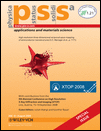In-phase and anti-phase interference fringes in Laue case
Abstract
By using X-rays from synchrotron radiation, we measured the rocking curves due to only the imaginary part of the atomic scattering factor in Laue case. The interference fringes are observed which are totally different from the Pendellösung fringe. The fringes of the diffracted and transmitted rocking curves are in-phase with each other. We studied the origin of the in-phase fringes by using the complex dispersion surface and the electric field in the crystal, and also the relation with a coupled pendulum.




